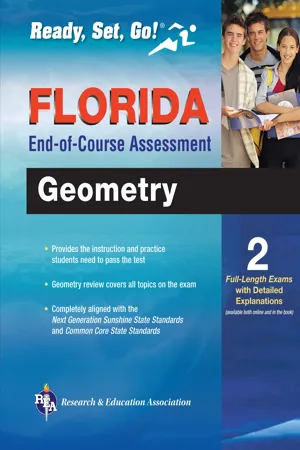Mathematics
Convexity in Polygons
Convexity in polygons refers to the property of a polygon where any line segment connecting two points within the polygon lies entirely within the polygon. A polygon is considered convex if it does not have any indentations or "dents" in its boundary. In other words, all interior angles of a convex polygon are less than 180 degrees.
Written by Perlego with AI-assistance
4 Key excerpts on "Convexity in Polygons"
Learn about this page
Index pages curate the most relevant extracts from our library of academic textbooks. They’ve been created using an in-house natural language model (NLM), each adding context and meaning to key research topics.
- Rebecca Dayton(Author)
- 2013(Publication Date)
- Research & Education Association(Publisher)
Convex vs. ConcaveA polygon is a two-dimensional closed shape with straight lines and is either convex or concave. Convex polygons are polygons whose interior angles are each less than 180°. That is, no angles point inward. Any polygon that is not convex is considered a concave polygon .Regular vs. Irregular
A regular polygon is a polygon with all equal angles and sides. If a polygon does not have equal angles and sides, then it is an irregular polygon .Interior Angles of Polygons
The sum of the interior angles of a polygon can be found using the following formula:(n − 2)180°where n is the number of sides in the polygon.Example: Find the sum of the interior angles of a 12-sided polygon.(n − 2)180°(12 − 2)180° (10)180° 1800° The sum of the interior angles of a 12-sided figure is 1800°. Example:Find the measure of each unknown angle, x .First, find the sum of the interior angles of the polygon. Since the polygon has 5 sides, it is a pentagon. The sum of the interior angles is determined as follows:(n − 2)180°(5 − 2)180° (3)180° 540° The sum of the interior angles of the figure is 540°.Using this sum, the following equation can be used to find the value of x :Exterior Angles of Polygons
Regardless of the number of sides in the polygon, the sum of the exterior angles is always 360° . An interior angle and one of the exterior angles at the same vertex are supplementary.Example: Steven is drawing a regular octagon. What is the measure of one exterior angle of the octagon?The sum of the exterior angles of any polygon is 360°. Since Steven is drawing an octagon, the figure will have 8 exterior angles. Each exterior angle is congruent because the octagon is regular. To determine the measure of one of the exterior angles, the total sum, 360°, is divided by 8.- eBook - ePub
The Geometry of Environment
An Introduction to Spatial Organization in Design
- Lionel March, Philip Steadman(Authors)
- 2020(Publication Date)
- Routledge(Publisher)
3H = {x | x.h ≤ 0}where x = [x y]T in R2 and [x y z]T in R3 . Effectively, what this definition says is that any vector x satisfying the condition will make an angle with the vector h such that its cosine will be negative.One of the most important, and certainly one of the most elegant, theorems on convexity is due to the French mathematician Carathéodory. If we have a closed bounded set of points xi then there exists a convex cover K (Figure 7.29 c) given byK = {x | x = ∑i a,xi , where ∑i ai = 1 and ai ≥ 0}.For example, given the four vertices of the bow-tie we have used before (Figure 7.30 )the convex cover is given by the set of pointsFigure 7.30where a1 + a2 + a3 + a4 = 1 and all of the ai are positive or zero. Is the point [0 1]T in the convex cover? This would req uire— a1 — a2 + a3 + a4 = 0— a1 + a2 — a3 +a4 = 1a1 + a2 + a3 + a4 = 1.These equations are satisfied for ai ≥ 0 by a1 = 0, a2 =1/2, a3 = 0, a4 = 1/2, so that the point does lie within the set. But does [0 3]T lie in the cover? This would req uire— a1 — a2 + a3 + a4 = 0- a1 + a2 - a3 + a4 = 3a1 + a2 + a3 + a4 = 1.Taking the last two equations and adding we find that2a2 + 2a4 = 4or thata2 + a4 = 2but this is impossible since a2 + a4 cannot eq ual 2 and satisfy the conditions that ∑i = 1 for this requires at least a1 or a3 to be negative, which is not permitted. Thus [0 3]T lies outside the cover. The convex cover of the bow-tie is a square centred on the origin with sides of length 2 (Fig - eBook - ePub
- Tony Cotton(Author)
- 2020(Publication Date)
- Routledge(Publisher)
concave (at least one interior angle is greater than 180°); or they may be regular (all sides the same length and all interior angles the same size) or irregular (having sides and angles which are different lengths and sizes).Closed shapes with straight sides are called polygons, and these are listed as follows. It is important to use both regular and irregular versions of the polygons with children, or otherwise they only link the name to the regular version of the shape.Within the set of polygons there are further classifications. So, for example, triangles can be:Portfolio task 9.2
Look at the shapes you sorted earlier in the chapter. For your portfolio sort them into groups using the vocabulary you have been introduced to earlier. For example, you may sort into concave and convex, regular and irregular, and so on.A triangle can be right-angled and isosceles or right-angled and scalene. Similarly, several quadrilaterals have special names:Equilateral All angles are 60° and all the sides are the same length. Right-angled One angle is 90°. Isosceles One pair of sides are the same length. Scalene All sides are different lengths. Square A quadrilateral with four equal sides and four right angles Rhombus A quadrilateral with four equal sides; the angles do not all have to be 90° (so a square is a specific version of a rhombus). Rectangle Any quadrilateral with four right angles. An oblong - eBook - ePub
Linear Optimization and Duality
A Modern Exposition
- Craig A. Tovey(Author)
- 2020(Publication Date)
- Chapman and Hall/CRC(Publisher)
− to be nonzero. Geometrically, we want the feasible region to comprise only the boundary of the positive quadrant, the positive parts of the horizontal and vertical axes. But that region is not convex, so we cannot force it to be the feasible region. To be convex, the feasible region must include the entire positive quadrant.Later in this chapter we will prove that for any finite set of points inℜ n, the set of all of their convex combinations is a polytope, and conversely for any polytope there exists a finite set of points whose convex combinations form that polytope. This equivalence is an aspect of duality. For now, observe how each definition is useful for different things. If I give you a point s and ask you, “Is s in this polytope?”, you would like to use the first definition. Simply computeA sand see if it is≤ b. But if I ask you to give me merely one point in the polytope, you have to solve a linear program. For the dual description of the polytope, the opposite is true. If I ask you whether s is in the polytope, you have to solve a linear program to know the answer. But if I ask you to give me a point in the polytope, you simply take one of the points from the dual description. If I ask you to give me many points in the polytope, you pick many sets of values,π 1…π Mand compute the convex combinations of the points given in the dual description.π i≥ 0 ;∑ i Mπ i= 1Summary: Polyhedra are the feasible regions of LPs. Memorize the definitions of convex combinations and convexity of a set. All polyhedra are closed and convex. Polytopes are bounded polyhedra.4.1 SeparationPreview: This section proves the separation theorem, an important duality property of polyhedra which is geometrically intuitive.We proved in the previous section that polyhedra are closed and convex subsets ofℜ n. Such subsets enjoy a duality property called separation.Theorem 4.1.1 LetS ⊂be closed and convex. Then for allℜ nx ∈eitherℜ nx ∈ Sor there existπ ∈,ℜ n(depending on x ) such thatπ 0∈ ℜπ · x <and for allπ 0s ∈ S, π



